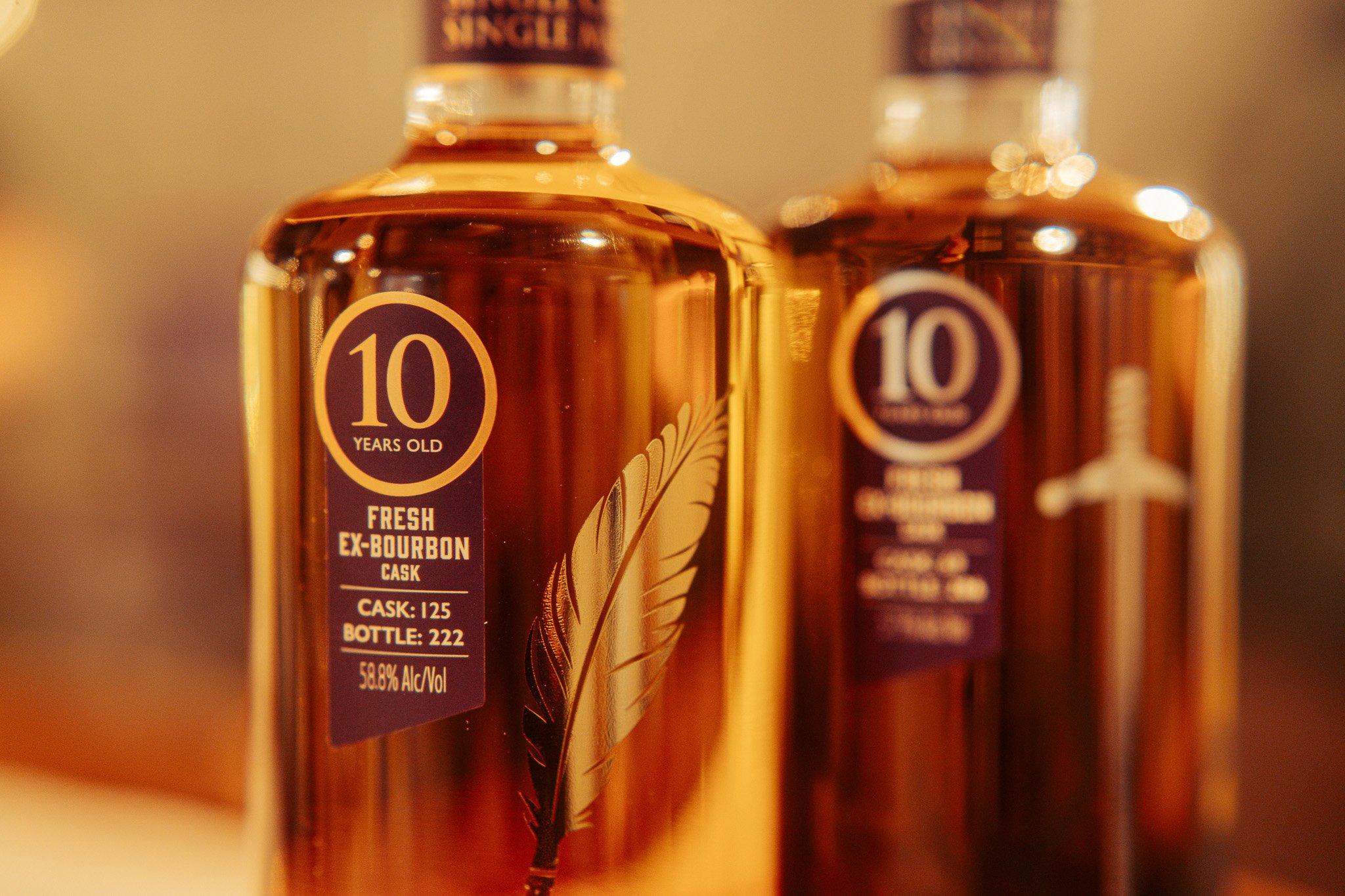Mellow fellow: meet Japan’s genius of distilling
Ice cool: Kanosuke whisky's main man Yoshitsugu Komasa
Kanosuke is an astonishing young whisky matured in rice wine barrels and produced on Japan’s ‘Mellow Coast.’ Barley gets a taste of the future
Kanosuke calls itself ‘Next Generation Japanese whisky from Kagoshima’s Mellow Coast.’ I like this seemingly straightforward tagline because it immediately conveys the ambition of this newish whisky-maker, as well as providing a clear sense of place (you might think this would be an obvious wheeze for all whisky brands but surprisingly few get it right). I’ll come back to that mellow place, which is key, but for now let’s get into that punchy vision.
The averred ambition to shape the drinking habits of the ‘next generation’ — surely an unspoken desire for all up-and-coming makers — really starts with the drive and acuity of the company’s forefathers. And with Japan’s native spirit — shochu. Yoshitsugu Komasa, founder, CEO and master blender of Kanosuke whisky, started out distilling rice wine shochu at his family’s Hioki Distillery. Shochu is in the family’s blood. And now whisky is too. His younger brother, Norihisa Komasa, runs the show at Hioki, Yoshitsugu having left in 2021 to concentrate his efforts fully on his new enterprise. The two still collaborate closely on blends, as we shall see.
Mellow coast, mellow whisky: the Kanosuke distillery has a glorious location
In 2017, Komasa named his new distillery after his grandfather, Kanosuke Komasa. Kanosuke was a pioneer with a dream. He wanted to make a shochu that would elevate the category and demand respect as a world class premium spirit. His inspiration was Scotch whisky. In 1957, he released ‘Mellowed Kozuru’, a barrel-aged rice shochu that helped transform perceptions of this utilitarian drink. It remains popular today. Kanosuke Whisky is an extension of this dream. Today in London, where we meet, Komasa is cradling his grandfather’s story to his workers’ shirt (he’s an artisan, certainly not a company suit) as he translates it for a new crowd of spirit drinkers, respecting origins but adding his own modern twist. His grandfather made a shochu inspired by whisky; Komasa has created a whisky inspired by shochu. The circle is complete.
Kanosuke has three copper stills, with an array of lyne arm angles
With 140-years of shochu-making expertise to draw on, we’re in professional hands, instinctively experimental ones, too. Since Komasa took the wheel, Kanosuke has steered a steady course between invention and tradition. He uses three pot stills with varying neck shapes and Lyne arm angles to allow him to tweak the character of the distillate, and create a mix of different aromas and flavours. With low-pressure distillation, steamed barley techniques and maturation in those re-charred ex- ‘Mellowed Kozuru’ shochu casks further adding to an air of innovation, these young whiskies have a singular quality that already (in my view) places Kanosuke at the head table of Japanese craft whisky.
‘Kanosuke is steered a steady course between invention and tradition - we’re in professional hands, but instinctively experimental ones, too’
Komasa leads our tasting, speaking English but also using a translator to deal with the excitable babble of accents coming from around the table (we’re excited because of what’s being poured into our glasses), and he’s a beguiling host. Passionate, deeply knowledgable and rightly proud of the peculiar whisky he is making on an idyllic peninsula in the southern tip of Japan. Is he as laid-back as the place he comes from? He certainly exudes a quiet confidence.
Candied ginger, orange peel and honey dance on the tongue
Location is everything. It always is with whisky. Komasa’s distillery was built on the beautiful Fukiagehama beach in Kagoshima — the ‘Mellow Coast’ — where summers are warm and cool and in winter fresh winds blow in from across the East China Sea. Sunsets are stunning. It’s the ideal environment for producing soft and elegant whisky, bursting with deep flavour and carrying an unmistakable whiff of salty sea air.
Kanosuke has launched three core whiskies (plus one UK-only limited edition). I tried them all and they are an impressive bunch of siblings, close, united by birth, but with their own personalities.
‘It’s the ideal environment for producing soft and elegant whisky, bursting with deep flavour and carrying an unmistakable whiff of salty sea air’
The signature Single Malt is a joy. Made with a small portion of peated malt and matured in ex-shochu, ex-sherry and American oak casks, it arrives with aromas of banana, salted caramel and cinnamon sugar. The palate is all candied ginger, orange peel and honey. And the finish is, well, undeniably mellow, with lingering notes of orange and that seaside singing gently. It’s got finesse as well as heft.
Kanosuke whisky mixes the art of Japan with Scots savvy. All of their whisky is distilled, aged and bottled in Japan. But, like generations of Japanese whisky-makers, Komasa has spent a lot of time in the cradle of Scotch honing his skills. One could say to an obsessional degree. When I asked him how many distilleries in Speyside he had visited on a recent fortnight-long trip he answered ‘around 50,’ with a nonchalant shrug and knowing smile. You get the sense there’s not many tricks of the trade that remain unseen by him or tiny details he hasn't stowed away for future use.
The quality of Japanese whisky is of course no longer a secret. Japan has been producing exceptional whisky for decades now and is fast emerging as a serious rival to Scotch. This summer, a team of esteemed whisky writers headed to Glasgow’s Pot Still bar for a special judging session. Their aim was to pit the best whisky from Scotland against some of the finest Japanese whiskies, to see who came out on top. The tasting would be blind to ensure there was no bias. The results were fascinating.
Kanosuke's trademark is a crisp, clean whisky with oodles of flavour
Cheekily named ‘The Judgement of Glasgow’, this tasting pow-wow was a competition comprising five categories: Single malt under £100; a single malt over £100; a blended whisky; a wildcard round; and a whisky highball (interesting that this category existed, showing how much cocktails have infiltrated the whisky-drinking lexicon in the past few years).
Japan won 3-2, eclipsing the old master, taking both the Single Malt under and over £100 categories as well as the highball head-to-head. Ten years ago this might have been a humiliating blow but not now. Nevertheless, Team Scotch was forced to lick its wounds and head back to the stillhouse, scratching its head and searching for answers.
Ambition is a strength if it’s backed by talent and expectation. In the case of Kanosuke, it doesn’t seem misplaced. They know this whisky is great. Perfect neat, or on the rocks, and — like most Japanese whisky — refreshing and delicious in a traditional mizuwari highball. You can see it in elegant bars being drunk by elegant people. If they can produce whisky of this quality in under five years (they carry no age statements but all these expressions are between 3-5 years old) imagine what the next wave of releases will be like? I don’t think it’s foolish to speak of them as being future world-beaters. Glasgow already knows what to expect. The rest of planet whisky will be waking up to that realisation soon enough.
Introducing Kanosuke’s Next Generation Range…
Kanosuke Japanese Single Malt Whisky (48%)
Made with a small portion of peated malt and matured in ex-shochu, ex-sherry, and American white oak casks. A gentle and mellow marvel, with aromas of banana, salted caramel and cinnamon sugar on the nose, leading to candied ginger, orange peel, and honey on the palate.
Kanosuke Hioki Japanese Pot Still Grain Whisky (51%)
Inspired by traditional Irish pot still expressions, this whisky is crafted from a blend of malted and unmalted barley and created using stainless steel pot still and vacuum distillation that is typically used for shochu production. Expect fresh apricot and plum custard with a good dash of vanilla and a pleasing marmalade tang.
Kanosuke Double Distillery Japanese Blended Whisky (53%)
An exquisite blend made by both the Komasa brothers, featuring malted and unmalted whiskies produced from 100% barley. It’s double distilled using a combination of Kanosuke’s three Miyake copper pot stills and Hioki’s stainless steel pot stills. rich and sweet, with notes of clove, black tea. Oaky and orangey on the finish. Delicious.
Kanosuke Japanese Single Malt Limited Edition 2023 Whisky (59% cask strength)
A sweet and smoky cask strength belter, aged in a variety of casks, including ex-shochu. The nose is filled with candy, vanilla, custard and bananas, followed by notes of salted caramel, wisps of smoke and Yatsuhashi - a traditional Japanese sweet. Smoked nuts on the finish. Wow.













